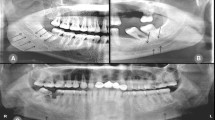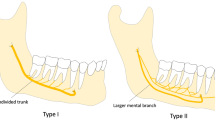Abstract
Purpose
The bifid mandibular canal is an anatomical variation, which causes anesthetic failure and surgical accidents occasionally. The purpose of this study is to observe the prevalence and anatomical location of bifid mandibular canals, providing clinical value in reducing the occurrence of surgical accidents and postoperative complications.
Methods
A total of 321 outpatients were selected in this study. Their CBCT images were observed, and the prevalence of bifid mandibular canals as well as the composition ratios of each branch type was evaluated according to the classification of Naitoh. The bifid mandibular canals and their branches’ diameter, length, horizontal distance to the buccal/lingual wall of the mandible, and vertical distance to the mandibular alveolar ridge were measured. Furthermore, 194 dry adult mandibles from the Department of Oral Anatomy and Physiology of Tianjin Medical University were observed to evaluate the prevalence and the average diameter of retromolar foramina.
Results
Of all the 321 patients, 84 (26.17%) cases of bifid mandibular canals and 105 (16.36%) sides of unilateral bifurcation were observed. Based on Naitoh’s classification, the retromolar canals were the most common types (46.67%), followed by the forward canals (40.00%), the dental canals (10.48%) and the buccolingual canals (2.86%). In 194 dry adult mandibles, 23 cases (11.86%) and 29 sides (7.47%) of retromolar foramina were found and the average diameter of retromolar foramina was 0.94 ± 0.30 mm.
Conclusion
More than a quarter of the population has the bifid mandibular canal, which is a potential factor of the onset of surgery accidents. CBCT is an effective method to identify the branches of mandibular canals. Preoperative CBCT examination can help reduce various postoperative complications.




Similar content being viewed by others
References
Auluck A, Pai KM, Mupparapu M (2007) Multiple mandibular nerve canals: radiographic observations and clinical relevance. Report of 6 cases. Quintessence Int 38:781–787
Bilecenoglu B, Tuncer N (2006) Clinical and anatomical study of retromolar foramen and canal. J Oral Maxillofac Surg 64:1493–1497
Chávez-Lomeli ME, Mansilla Lory J, Pompa JA, Kjaer I (1996) The human mandibular canal arises from three separate canals innervating different tooth groups. J Dent Res 75:1540–1544. https://doi.org/10.1177/00220345960750080401
de Oliveira-Santos C, Souza PH, de Azambuja B-C et al (2012) Assessment of variations of the mandibular canal through cone beam computed tomography. Clin Oral Investig 16:387–393. https://doi.org/10.1007/s00784-011-0544-9
Fu E, Peng M, Chiang CY et al (2014) Bifid mandibular canals and the factors associated with their presence: a medical computed tomography evaluation in a Taiwanese population. Clin Oral Implants Res 25:e64–67. https://doi.org/10.1111/clr.12049
Fukami K, Shiozaki K, Mishima A et al (2012) Bifid mandibular canal: confirmation of limited cone beam CT findings by gross anatomical and histological investigations. Dentomaxillofac Radiol 41:460–465. https://doi.org/10.1259/dmfr/60245722
Haghighat A, Jafari Z, Hasheminia D et al (2015) Comparison of success rate and onset time of two different anesthesia techniques. Med Oral Patol Oral Cir Bucal 20:e459–463. https://doi.org/10.4317/medoral.20526
Kalantar Motamedi MH, Navi F, Sarabi N (2015) Bifid mandibular canals: prevalence and implications. J Oral Maxillofac Surg 73:387–390. https://doi.org/10.1016/j.joms.2014.09.011
Kang JH, Lee KS, Oh MG et al (2014) The incidence and configuration of the bifid mandibular canal in Koreans by using cone-beam computed tomography. Imaging Sci Dent 44:53–60. https://doi.org/10.5624/isd.2014.44.1.53
Kasabah S, Modellel Y (2013) Classification of bifid mandibular canals in the Syrian population using panoramic radiographs. East Mediterr Health J 19:S178–183
Kawai T, Asaumi R, Sato I et al (2012) Observation of the retromolar foramen and canal of the mandible: a CBCT and macroscopic study. Oral Radiol 28:10–14
Kuczynski A, Kucharski W, Franco A et al (2014) Prevalence of bifid mandibular canals in panoramic radiographs: a maxillofacial surgical scope. Surg Radiol Anat 36:847–850. https://doi.org/10.1007/s00276-014-1298-2
Kuribayashi A, Watanabe H, Imaizumi A et al (2010) Bifid mandibular canals: cone beam computed tomography evaluation. Dentomaxillofac Radiol 39:235–239. https://doi.org/10.1259/dmfr/66254780
Lew K, Townsen G (2006) Failure to obtain adequate anaesthesia associated with a bifid mandibular canal: a case report. Aust Dent J 51:86–90. https://doi.org/10.1111/j.1834-7819.2006.tb00406.x
Motamedi MH, Gharedaghi J, Mehralizadeh S, Navi F, Badkoobeh A, Valaei N, Azizi T (2016) Anthropomorphic assessment of the retromolar foramen and retromolar nerve: anomaly or variation of normal anatomy? Int J Oral Maxillofac Surg 45:241–244. https://doi.org/10.1016/j.ijom.2015.10.017
Muinelo- Lorenzo J, Suarez- Quintanilla JA, Fernandez- Alonso A et al (2014) Descriptive study of the bifid mandibular canals and retromolar foramina: cone beam CT vs panoramic radiography. Dentomaxillofac Radiol 43:20140090. https://doi.org/10.1259/dmfr.20140090
Naitoh M, Hiraiwa Y, Aimiya H et al (2009) Observation of bifid mandibular canal using cone-beam computerized tomography. Int J Oral Maxillofac Implants 24:155–159
Orhan K, Aksoy S, Bilecenoglu B et al (2011) Evaluation of bifid mandibular canals with cone-beam computed tomography in a Turkish adult population: a retrospective study. Surg Radiol Anat 33:501–507. https://doi.org/10.1007/s00276-010-0761-y
Ossenberg NS (1987) Retromolar foramen of the human mandible. Am J Phys Anthropol 73:119–128. https://doi.org/10.1002/ajpa.1330730112
Rashsuren O, Choi JW, Han WJ et al (2014) Assessment of bifid and trifid mandibular canals using cone-beam computed tomography. Imaging Sci Dent 44:229–236. https://doi.org/10.5624/isd.2014.44.3.229
Rossi AC, Freire AR, Prado GB et al (2012) Incidence of retromolar foramen in human mandibles: ethnic and clinical aspects. Int J Morphol 30:1074–1078
Sheikhi M, Badrian H, Ghorbanizadeh S (2012) Bilateral bifid mandibular canal. Dent Res J 9:S132–135
Truong MK, He P, Adeeb N et al (2017) Clinical anatomy and significance of the retromolar foramina and their canals: a literature review. Cureus 9:e1781. https://doi.org/10.7759/cureus.1781
Villaça-Carvalho MF, Manhães LR Jr, de Moraes ME et al (2016) Prevalence of bifid mandibular canals by cone beam computed tomography. Oral Maxillofac Surg 20:289–294. https://doi.org/10.1007/s10006-016-0569-y
von Arx T, Hänni A, Sendi P et al (2011) Radiographic study of the mandibular retromolar canal: an anatomic structure with clinical importance. J Endod 37:1630–1635. https://doi.org/10.1016/j.joen.2011.09.007
Wang Q, Yan H, Chen Z et al (2015) The three-dimensional imaging studies of mandibular canal branch in retromolar region. Chin J Med 50:71–74. https://doi.org/10.3969/j.issn.1008-1070.2015.03.021
Yang X, Lyu C, Zou D (2017) Bifid mandibular canals incidence and anatomical variations in the population of Shanghai area by cone beam computed tomography. J Comput Assist Tomogr 41:535–540. https://doi.org/10.1097/RCT.0000000000000561
Zhang Z, Fan W, Zhang G (2016) Anatomical and radiographical studies of the bifid mandibular canal. Zhonghua Kou Qiang Yi Xue Za Zhi 51:185–188. https://doi.org/10.3760/cma.j.issn.1002-0098.2016.03.012
Author information
Authors and Affiliations
Contributions
JZ and XZ contributed to the study conception and design. Data collection was performed by XG. Data analysis was performed by XZ. The first draft of the manuscript was written by XZ and manuscript was edited by JZ. All authors read and approved the final manuscript.
Corresponding author
Ethics declarations
Conflict of interest
The authors declare that they have no conflict of interests.
Additional information
Publisher's Note
Springer Nature remains neutral with regard to jurisdictional claims in published maps and institutional affiliations.
Rights and permissions
About this article
Cite this article
Zhou, X., Gao, X. & Zhang, J. Bifid mandibular canals: CBCT assessment and macroscopic observation. Surg Radiol Anat 42, 1073–1079 (2020). https://doi.org/10.1007/s00276-020-02489-5
Received:
Accepted:
Published:
Issue Date:
DOI: https://doi.org/10.1007/s00276-020-02489-5




